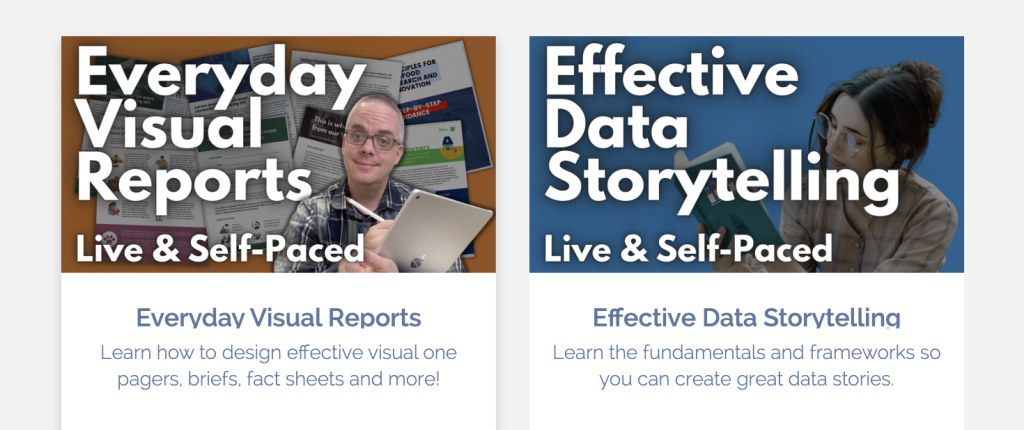This is an Eval Central archive copy, find the original at freshspectrum.com.
If I could go back in time to my university days, I would certainly take some different electives.
Like so many of you, I spent my time in college learning how to be a social scientist. Which included absolutely zero practical creative or design courses. My professional evolution would probably have been easier if I had taken just a few credit hours on graphic design, user experience design, and creative storytelling.
But alas, that’s not how things work. The good thing is, with countless blogs, books, and YouTube, there has never been a better time to teach yourself new stuff. Even if you can’t commit a semester to a single course.

Starting with a creative self-assessment.
If you’re here, I’m going to assume you’re likely a data person of some sort. This blog is read by a lot of program evaluators, social science researchers, and all sorts of other data folk.
I think it’s a good idea, every once and awhile, to take stock of your creative ability. Because even though we never learned this stuff in grad school, creative expectations are on a continuous rise.
And since many of those rising expectations are self-imposed, the best way to take stock is with a simple creative self-assessment. So pull out some paper and follow along with me.
Rate yourself twice.
For each of the following questions I want you to rate yourself twice.
- The scale for both is 1 to 5, with 1 being “very uncomfortable with your ability to do this task” and 5 being “very comfortable with your ability to do this task.”
- The first rating is your current comfort level with the specific creative skill.
- The second rating is an aspirational comfort level (where do you want to be in terms of the particular creative skill).
- You don’t need to be an expert at everything!
Here is a set of skills based on my discussions of practical creative challenges data people face on a regular basis. Rate yourself twice for each one.
Creative Skills for Data People
This is a self-assessment just for you, so be honest with your ratings.
1 (= Very Uncomfortable) to 5 (= Very Comfortable)
Here are 30 skills.
- Create a good presentation slide deck.
- Deliver an interesting presentation.
- Create basic charts and graphs.
- Create advanced charts and graphs.
- Find effective data stories.
- Tell effective data stories.
- Create a short visual report.
- Create a little infographic for social media.
- Create an easy to understand visual slidedoc.
- Write a blog post.
- Write a series of social media posts.
- Write an effective email newsletter.
- Evaluate digital dissemination efforts.
- Get a creative project approved by a non-creative boss or client.
- Share creative responsibilities with a team.
- Create a mood board.
- Develop a user persona.
- Adapt a long report into a slide doc.
- User test a report.
- Increase the readability of a long report.
- Develop a high quality data dashboard.
- Develop a simple interactive report.
- Develop a comprehensive web report.
- Produce a video.
- Develop a storyboard.
- Illustrate a qualitative report.
- Adapt a long report into a series of infographics.
- Annotate a chart or graph.
- Settle creative disagreements.
- Find creative inspiration.
Okay, that’s it for now. I might add more over time, but that should give you a good starter assessment.
Now, how to improve.
Going from a 1 to a 2.
This is just about learning the basics. You can a learn a lot by just spending an afternoon hopping around the internet, watching videos and going down rabbit holes.
Going from a 2 to a 3.
This is where you go from simply knowing to doing. If you were learning to cook, this is where you start following recipes. Here you can spend more time on YouTube and blogs following tutorials, maybe take a basic course.
Going from a 3 to a 4.
This is where your skills improve. At this stage you need ongoing practice to develop your techniques. Try for gradual but constant improvement. Take courses from people with first hand experience. Finding a mentor can help speed up the process.
At a comfort level of 4, you already have more skill than most of your data colleagues. You might even be asked to train others, or get requests to lead bigger creative projects.
Going from a 4 to a 5.
You are no longer just a leader in your office, you a leader in the field. At a 5 you feel comfortable offering workshops of your own or even building a business around your creative skills.
Going from 4 to 5 requires a lot of repetition (practice, practice, practice). At this stage you are starting to develop your own person style and process. Mentorship can help you discover the little things that you can do to get better.

About my blog and DiY Data Design Courses
The goal of the blog (and my YouTube channel) is to get you from a 1 or 2 to a 2 or 3. A lot of that is just about knowing what exists and learning some basic recipes.
The goal of my courses is to get you from a 2 or 3 to a 3 or 4. You can do this through self study, but my courses are designed to make it happen faster. And the tailored support and mentoring I provide through office hours can help you grow into that 4 or 5 range.
Courses available right now (fully self-paced with office hours and future live sessions included).